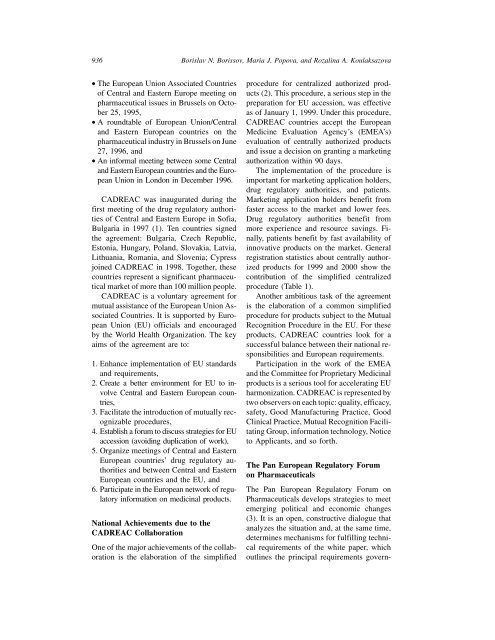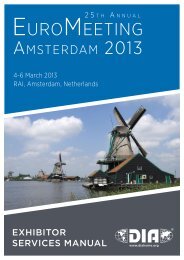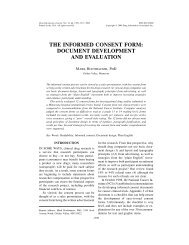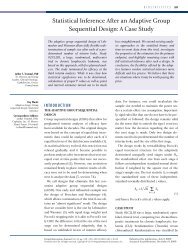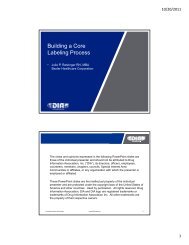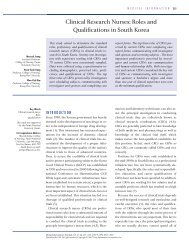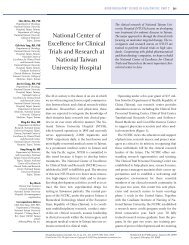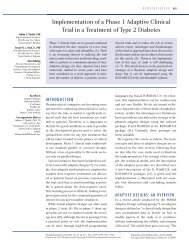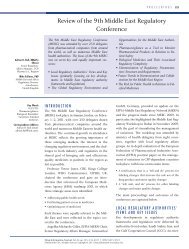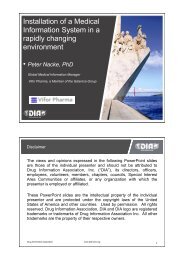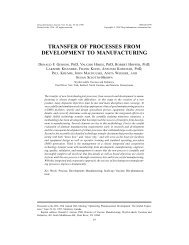transition challenges for collaboration agreement of drug regulatory ...
transition challenges for collaboration agreement of drug regulatory ...
transition challenges for collaboration agreement of drug regulatory ...
You also want an ePaper? Increase the reach of your titles
YUMPU automatically turns print PDFs into web optimized ePapers that Google loves.
936 Borislav N. Borissov, Maria J. Popova, and Rozalina A. Koulaksazova<br />
• The European Union Associated Countries procedure <strong>for</strong> centralized authorized prod-<br />
<strong>of</strong> Central and Eastern Europe meeting on ucts (2). This procedure, a serious step in the<br />
pharmaceutical issues in Brussels on Octo- preparation <strong>for</strong> EU accession, was effective<br />
ber 25, 1995,<br />
as <strong>of</strong> January 1, 1999. Under this procedure,<br />
• A roundtable <strong>of</strong> European Union/Central CADREAC countries accept the European<br />
and Eastern European countries on the Medicine Evaluation Agency’s (EMEA’s)<br />
pharmaceutical industry in Brussels on June evaluation <strong>of</strong> centrally authorized products<br />
27, 1996, and<br />
and issue a decision on granting a marketing<br />
• An in<strong>for</strong>mal meeting between some Central authorization within 90 days.<br />
and Eastern European countries and the Euro- The implementation <strong>of</strong> the procedure is<br />
pean Union in London in December 1996. important <strong>for</strong> marketing application holders,<br />
<strong>drug</strong> <strong>regulatory</strong> authorities, and patients.<br />
CADREAC was inaugurated during the Marketing application holders benefit from<br />
first meeting <strong>of</strong> the <strong>drug</strong> <strong>regulatory</strong> authori- faster access to the market and lower fees.<br />
ties <strong>of</strong> Central and Eastern Europe in S<strong>of</strong>ia, Drug <strong>regulatory</strong> authorities benefit from<br />
Bulgaria in 1997 (1). Ten countries signed more experience and resource savings. Fi-<br />
the <strong>agreement</strong>: Bulgaria, Czech Republic, nally, patients benefit by fast availability <strong>of</strong><br />
Estonia, Hungary, Poland, Slovakia, Latvia, innovative products on the market. General<br />
Lithuania, Romania, and Slovenia; Cypress registration statistics about centrally authorjoined<br />
CADREAC in 1998. Together, these ized products <strong>for</strong> 1999 and 2000 show the<br />
countries represent a significant pharmaceu- contribution <strong>of</strong> the simplified centralized<br />
tical market <strong>of</strong> more than 100 million people. procedure (Table 1).<br />
CADREAC is a voluntary <strong>agreement</strong> <strong>for</strong> Another ambitious task <strong>of</strong> the <strong>agreement</strong><br />
mutual assistance <strong>of</strong> the European Union As- is the elaboration <strong>of</strong> a common simplified<br />
sociated Countries. It is supported by Euro- procedure <strong>for</strong> products subject to the Mutual<br />
pean Union (EU) <strong>of</strong>ficials and encouraged Recognition Procedure in the EU. For these<br />
by the World Health Organization. The key products, CADREAC countries look <strong>for</strong> a<br />
aims <strong>of</strong> the <strong>agreement</strong> are to: successful balance between their national responsibilities<br />
and European requirements.<br />
1. Enhance implementation <strong>of</strong> EU standards Participation in the work <strong>of</strong> the EMEA<br />
and requirements, and the Committee <strong>for</strong> Proprietary Medicinal<br />
2. Create a better environment <strong>for</strong> EU to in- products is a serious tool <strong>for</strong> accelerating EU<br />
volve Central and Eastern European coun- harmonization. CADREAC is represented by<br />
tries,<br />
two observers on each topic: quality, efficacy,<br />
3. Facilitate the introduction <strong>of</strong> mutually rec- safety, Good Manufacturing Practice, Good<br />
ognizable procedures,<br />
Clinical Practice, Mutual Recognition Facili-<br />
4. Establish a <strong>for</strong>um to discuss strategies <strong>for</strong> EU tating Group, in<strong>for</strong>mation technology, Notice<br />
accession (avoiding duplication <strong>of</strong> work),<br />
5. Organize meetings <strong>of</strong> Central and Eastern<br />
to Applicants, and so <strong>for</strong>th.<br />
European countries’ <strong>drug</strong> <strong>regulatory</strong> authorities<br />
and between Central and Eastern<br />
European countries and the EU, and<br />
The Pan European Regulatory Forum<br />
on Pharmaceuticals<br />
6. Participate in the European network <strong>of</strong> regu- The Pan European Regulatory Forum on<br />
latory in<strong>for</strong>mation on medicinal products. Pharmaceuticals develops strategies to meet<br />
emerging political and economic changes<br />
National Achievements due to the<br />
CADREAC Collaboration<br />
(3). It is an open, constructive dialogue that<br />
analyzes the situation and, at the same time,<br />
determines mechanisms <strong>for</strong> fulfilling techni-<br />
One <strong>of</strong> the major achievements <strong>of</strong> the collabcal requirements <strong>of</strong> the white paper, which<br />
oration is the elaboration <strong>of</strong> the simplified outlines the principal requirements govern-


